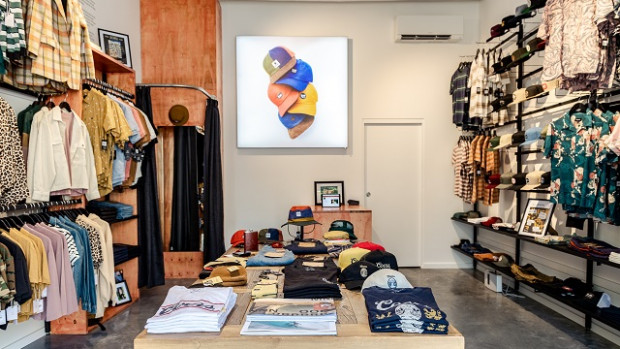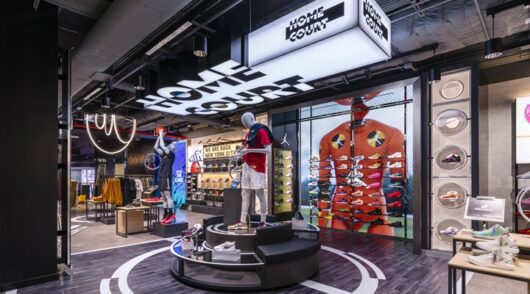It’s been a difficult decade for bricks-and-mortar retailers. From falling foot traffic to increasing rental pressures, the challenges that physical storefronts present have often proved too burdensome to overcome, particularly for international brands looking to break into the Australian market. Take, for instance, Debenhams. In July, the massive UK retailer announced it would shut up shop in Australia after three years of dwindling trade failed to make an impact. Similarly, local brand Harri
rris Scarfe was forced to call in administrators in December, just one month after being acquired by private equity firm Allegro Funds.
For some, these failures signalled the beginning of a much-anticipated end. Industry experts have long argued that the arrival of e-commerce platforms would lead to the cannibalisation of the bricks-and-mortar – a theory that has seen many international and domestic retailers shy away from the traditional format.
So why has Californian-based lifestyle brand Brixton launched a global flagship storefront after 15 successful years of operating as a wholesaler? And why in Sydney?
“It’s all about experience. How do you stand out in a crowded market?” says Australasian managing director Mark Nelmes.
“You can look at brands pulling out of bricks-and-mortar as a hit to the industry, but I see it as a real opportunity. No-one else is doing this, so there’s a bigger opportunity for us to capture the market.”
In late December, the vintage-inspired retailer opened the doors to its first storefront in Surry Hills. The move turned heads, not merely because it was brand-first, but because it seemingly went against the collective retail sentiment.
“You read the reports and you hear the doom and gloom, but the night is always darkest before the dawn,” Nelmes says.
“A big reason why we decided to launch the store was because the online marketplace is just so busy, so congested. This is a way for us to cut through the noise and display our brand story in full.”
Nelmes and the Brixton brand join a select few retailers embracing a new era of bricks-and-mortar operation known as destination retailing.
Making the customer feel special
The concept is simple. Rather than relying on traditional product offerings to drive in-store traffic, retailers are increasingly turning to experience-based installations and events.
Eloise Zoppos, a senior research consultant at Monash University, says that retailers can buck the e-commerce competition by focusing on the aspects that differentiate in-store and online experiences.
“One answer is to invest in and enhance those aspects of the shopping experience that online retailers just can’t provide,” she says.
Aussie swimwear brand Seafolly turned its sights to technological innovation, for example, introducing an interactive mirror in the fitting room of its Bondi Junction store in Sydney. Department store David Jones took a different approach, favouring a VIP experience that couldn’t be replicated at home.
“Shopping online is highly convenient but it doesn’t necessarily make you feel special,” Zoppos says. “Some bricks-and-mortar retailers are positioning themselves at the premium end of the shopping market by appealing to the human desire to be pampered.”
Marrying in-store experience with established culture values can be difficult, particularly for a youth-focused lifestyle and streetwear brand such as Brixton.
“The speed, multiple marketing channels, fast trends and distribution has definitely changed as a result of social media, e-commerce platforms and easy payment offerings. This presents challenges, but exciting challenges,” Nelmes says.
To combat the evolving market demands, millennial and generation Z-focused retailers have had to double down on their demographic data collection, taking into account not only buying habits, but cultural habits. It’s one of the reasons why Brixton chose Surry Hills for its inaugural retail outlet.
“Surry Hills was the perfect location for us to bring our retail space to life – with its blue-collar roots and creative energy – being part of an authentic community that breathes our lifestyle was very important to the brand,” Nelmes says.
He went on to reveal that in addition to offering men’s and women’s headwear, apparel, and accessories, the new flagship store will also host local music events art shows, and surf and skate video premieres.
“Having an ever-evolving space that we can use to educate people about our brand, showcase seasonal stories, launch collaborative concepts and host cultural events is something that we have always dreamed of doing,” he says.
“Young kids are so transitional in their habits. What works today won’t work tomorrow, so you have to constantly revitalise your brand.”
Following that line of thinking, the new global flagship store has also integrated an innovative click-and-collect offering. The high street location was specifically chosen for its street parking and collection capabilities, where customers can scan and pick up items ordered online within hours of purchasing.
“We run on the ethos that we don’t play defence, we only play offence. No one else is doing this, so there’s a bigger opportunity for us to capture the market.”
By adopting this new format of destination retailing, Brixton has opened the door for deeper and more consistent consumer interaction, offering several new touchpoints.
“The idea of Brixton retail is about immersion and communities. We want to tell stories and learn more about what our consumers want in much closer proximity to them.”
Breaking out globally
It’s been a big 12 months for the brand. In spring, Brixton debuted its women’s line in response to the growing female-driven street-and-skate movement.
“Building on our success of key headwear pieces, the Brixton woman was wanting more from us. The women’s collection and its inspiration is very true to the brand. We envision women’s to be a major growth driver for our business in the coming years,” Nelmes says.
He isn’t the only one leading that vision. In March, founders David Stoddard, Jason Young, Mike Chapin took a step back from the business, welcoming former Adidas Group and Under Armour executive Raphael Peck to the fold as global CEO.
It’s a move that has significantly altered the way Brixton operates, with Nelmes revealing the change in leadership has allowed the brand to break its critical mass plateau.
“The original founders have done a fantastic job to get Brixton to where it is today, but as a company, it was time to accelerate the brand globally – and finding Raphael has been key in this process,” he says.
“Raphael has definitely increased the pace of the company. His eye for detail has been key to crafting a refined brand direction with a focus on engaging product, quality and marketing concepts.”
But by far, the biggest advancement revolves around the latest bricks-and-mortar development.
Peck revealed that he plans to roll out the new concept globally, pending its success Down Under.
“In addition to Australia, we’ll be focused on retail experiences in the US, as well as Japan in 2020, to give consumers an opportunity to touch and feel Brixton in a well-curated, elevated space that creates community in the cities in which we open,” he says.
International fans will have to wait, however, and for the time being, Australia remains the only market with a Brixton bricks-and-mortar outlet. But despite the exciting new developments, wholesale is set to remain the brand’s number one priority.
“Our dynamic retail spaces will allow us to finally create physical touchpoints of our brand, which will help our longstanding wholesale partners in driving consumer demand and recognition globally,” Nelmes says.
“But through that, we must ensure we keep the emotional connection within our target community and make people feel – this is something that has been important to Brixton since day one and remains our greatest focus. Brands that are remaining true are the brands that are succeeding in the market.”
It’s certainly a bold move for an established brand to take the leap on experimental retail, particularly in light of evolving market conditions. However, Nelmes believes the formats can not only coexist, but strengthen the overall offering.
“We’ve really gone all in on this one,” he explains. “But like I said, we don’t play defence, only offence.”







